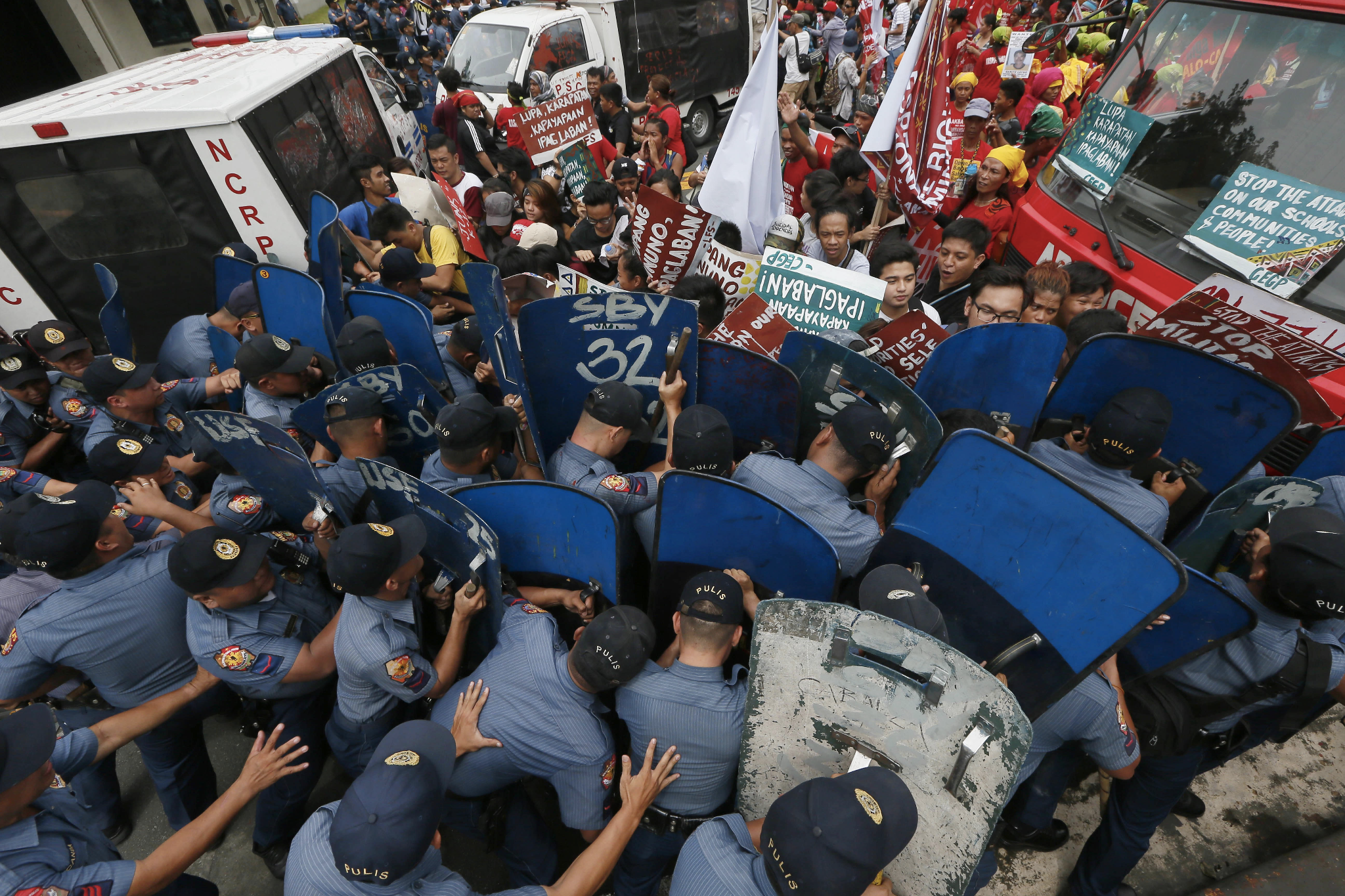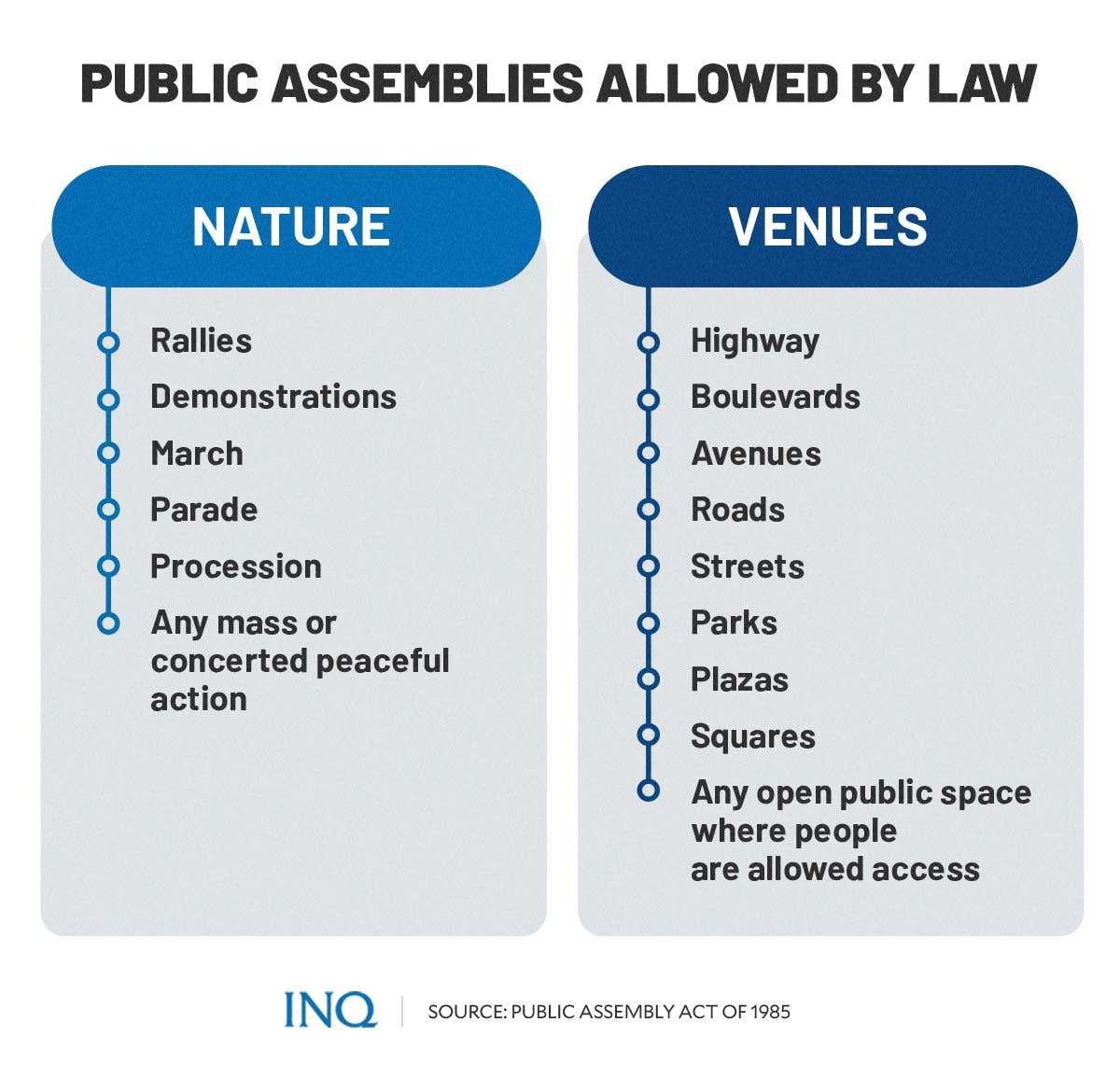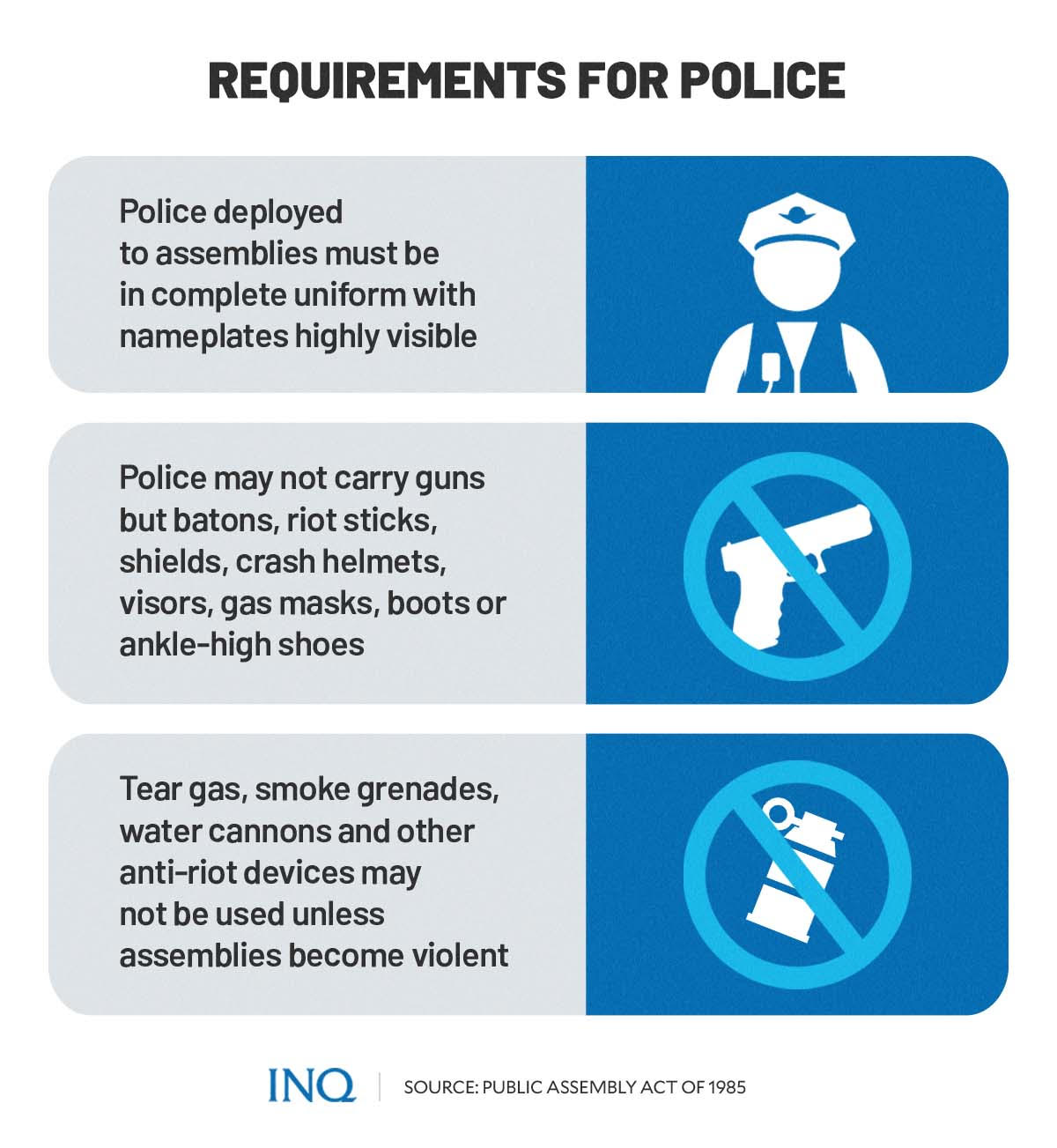Protests and dispersals: What to know

FILE PHOTO: Manila policemen with shields block protesters from approaching the US Embassy on Oct. 19, 2016. Dozens were hurt when cops forcibly dispersed the protesters calling for an independent foreign affairs policy for the Philippines.
MANILA, Philippines—“Essential and vital to the strength and stability of the State”.
This was how Batas Pambansa (BP) Bilang 880 described the constitutional right of the people peaceably to assemble and petition the government for redress of grievances, stressing that the State shall make certain the free exercise of this right without prejudice to the rights of others to life, liberty and equal protection of the law.
However, last Wednesday (May 25), a protest within the compound of the Commission on Human Rights (CHR) in Diliman, Quezon City was dispersed by police using water cannons.
READ: Anti-Marcos rally inside CHR compound turns violent amid dispersal by police
The protest, which was attended by 200 individuals, had been joined by victims of the martial law who were assailing the impending proclamation of Ferdinand Marcos Jr. as president-elect at the Batasang Pambansa.
The National Capital Region Police Office (NCRPO) said an estimated 200 protesters were at CHR’s Liwasang Diokno, a freedom park where people are allowed to stage a public assembly “even without a permit”.
Article continues after this advertisementA freedom park, the law stated, is a place in every city or municipality that is designated within six months since the effectivity of BP 880: “As far as practicable, shall be centrally located within the poblacion where demonstrations and meetings may be held at any time without the need of any prior permit.”
Article continues after this advertisement
GRAPHIC: Ed Lustan
A public assembly, which can be held on a highway, boulevard, avenue, road, street, park, plaza and any open space of public ownership where the people are allowed access, can be a rally, demonstration, march, parade, procession or any mass or concerted action for these purposes:
- To present a lawful cause
- To express an opinion to the general public on any issue
- To protest or influence any state of affairs—political, economic or social
- To petition the government for redress of grievances
The NCRPO said the protesters attempted to proceed outside the Liwasang Diokno to advance toward Batasang Pambansa. It said “a brief scuffle ensued when a group of protesters who were denied passage along Commonwealth Avenue attacked police contingents.”
“Protesters tried to kick and waggle the shields of the police force,” the NCRPO said while stressing that the incident prompted the firemen to bomb the protesters with water.
However, human rights group Karapatan, which condemned “in strongest possible terms” the attempt of the Philippine National Police (PNP) to violently disperse the peaceful indignation protest, stressed that what the police said were lies.
Health marshals, it said, have reported that 10 protesters were injured “after being hit with truncheons and shields while the protest was being bombed with water”. The police, however, said broken shields, which are made out of plastic, “may have caused injury to anybody who has come in contact with it if applied with considerable force”.
“We will not take these violations sitting down, and in the face of the looming return of the forces of tyranny and fascism, all the more that we will protest and resist any and all attempts to unleash the horrors of martial law and State repression,” Karapatan said.
The dispersal of the protest within the CHR compound came a few days after the dispersal of activists who were on their way to the United States (US) Embassy in Manila to protest the visit of US President Joseph Biden to South Korea and Japan.
READ: Campus journalist in US Embassy rally arrested
What does the law say?
BP 880—or the Public Assembly Act—stated that a written permit shall be required for any person or persons to organize and hold a public assembly in a public place. However, no permit shall be required if the public assembly shall be done or made in a freedom park duly established by law or ordinance.

GRAPHIC: Ed Lustan
It explained that when a public assembly is held on private property, the consent of the owner or the one entitled to its legal possession is needed. When the public assembly is held within the campus of a government-owned and operated educational institution, it shall be governed by the rules and regulations of the said institution.
Here’s what you need to know when you need to seek a permit:
- The applications shall be in writing and shall include the names of the leaders or organizers; the purpose of such public assembly; the date, time and duration, and place or streets to be used for the intended activity; and the probable number of persons participating, the transport and the public address systems to be used.
- The application shall incorporate the duty and responsibility of the applicant as stated in Section 8 of the law—the responsibilities of the applicant.
- The application shall be filed with the office of the mayor of the city or municipality in whose jurisdiction the intended activity is to be held, at least five working days before the scheduled activity.
- Upon receipt of the application, which must be duly acknowledged in writing, the office of the city or municipal mayor shall cause the same to immediately be posted at a conspicuous place in the city or municipal building.
However, lawyer Edre Olalia, the president of the National Union of People’s Lawyers which took the fight against the law before the Supreme Court, said the permit should not be the basis to exercise one’s right—a constitutional and even a universal right.
“The permit is a mere administrative requirement. It is not a condition sine qua non (essential) for the exercise of a peaceful public assembly,” he told INQUIRER.net.
The law stated that the applicant shall have these responsibilities to make certain that the public assembly will be peacefully conducted in accordance with the conditions set in the permit given by the local government unit:
- To inform the participants of their responsibility under the permit.
- To police the ranks of the demonstrators in order to prevent non-demonstrators from disrupting the lawful activities of the public assembly.
- To confer with local government officials concerned and law enforcers to the end that the public assembly may be held peacefully.
- To see to it that the public assembly undertaken shall not go beyond the time stated in the permit.
- To take positive steps that demonstrators do not molest any person or do any act unduly interfering with the rights of other persons not participating in the public assembly.
Police interference in protests
While the law is clear that law enforcers shall not interfere with the holding of a public assembly, a law enforcement contingent under the command of a responsible police officer may be detailed and stationed in a place at least 100 meters away from the area of activity ready to maintain peace and order at all times.

GRAPHIC: Ed Lustan
When police assistance is requested, however, the law has set these guidelines
- Members of the law enforcement contingent who deal with the demonstrators shall be in complete uniform with their nameplates and units to which they belong displayed prominently on the front and dorsal parts of their uniform and must observe the policy of “maximum tolerance”.
This means that the highest degree of restraint shall be observed by the military, police and other peacekeeping officials, especially in the dispersal of a public assembly.
- The members of the law enforcement contingent shall not carry any kind of firearms but may be equipped with baton or riot sticks, shields, crash helmets with visor, gas masks, boots or ankle high shoes with shin guards.
- Tear gas, smoke grenades, water cannons, or any similar anti-riot device shall not be used unless the public assembly is attended by actual violence or serious threats of violence, or deliberate destruction of property.
When should dispersals take place?
BP 880 stated that no public assembly with a permit shall be dispersed, however, when an activity becomes violent, the police may disperse:
- At the first sign of impending violence, the ranking officer of the law enforcement contingent shall call the attention of the leaders of the public assembly and ask the latter to prevent any possible disturbance.
- If actual violence starts to a point where rocks or other harmful objects from the participants are thrown at the police or at the non-participants, or at any property causing damage to such property, the ranking officer of the law enforcement contingent shall audibly warn the participants that if the disturbance persists, the public assembly will be dispersed.
- If the violence or disturbances prevailing as stated in the preceding paragraph should not stop or abate, the ranking officer of the law enforcement contingent shall audibly issue a warning to the participants of the public assembly, and after allowing a reasonable period of time to lapse, shall immediately order it to disperse.
- No arrest of any leader, organizer or participant shall also be made during the public assembly unless he violates during the assembly a law, statute, ordinance or any provision of the BP 880.
- Isolated acts or incidents of disorder or branch of the peace during the public assembly shall not constitute a group for dispersal.
“When the public assembly is held without a permit where a permit is required, the said public assembly may be peacefully dispersed,” the law stated.
For Olalia, the police should always keep in mind the standard of maximum tolerance: “What they are doing is minimum intolerance. Why not negotiate with the protesters? Violence takes place because of the minimum intolerance.”
“How many were the protesters yesterday? The police action of blocking their way was a provocation. Instead of deescalating [the tension], it even escalated, heightened,” he said.
Activist Kej Andres, who was at the CHR compound during the dispersal, told INQUIRER.net that they were still inside the Liwasang Diokno when the police started blocking their way even when they only asserted having the protest at the sidewalk or at the first lane, “like what we are usually doing”.
“As we were trying to advance, the police used truncheons to hurt […] the others even had yantoks. Even our poster was grabbed along with an elderly official of the Samahan ng Ex-Detainees Laban sa Detensyon at Aresto, who is also a victim of martial law,” activist Jong Juguilon said.
One of the actions prohibited by the law is “obstructing, impeding, disrupting or otherwise denying the exercise of the right to peaceful assembly”.
No arrests
During the protest near the US Embassy in Manila, two activists were arrested, including a campus journalist, Lloyd Manango of the University of the Philippines Manila-College of Arts and Sciences.
Manango was also released later that day, but Olalia said his arrest could already be considered illegal: “There is a jurisprudence that an invitation, if against one’s wishes, is already an illegal arrest.”
He said the general rules on warrantless arrest, as stated in the Rules of Court, Rule 113, Section 5, also apply. These are the rules, as listed by the PNP website:
- When, in the presence of the policeman, the person to be arrested has committed, is actually committing, or is attempting to commit an offense. This is the “in flagrante delicto” rule.
- When an offense has just been committed, and he has probable cause to believe, based on personal knowledge of facts or circumstances, that the person to be arrested has committed it. This is the “hot pursuit” arrest rule.
Manango, however, was only covering the protest when he was taken by the police and brought to the station.